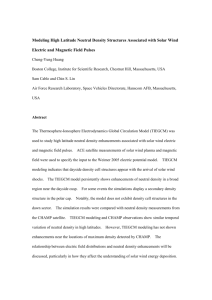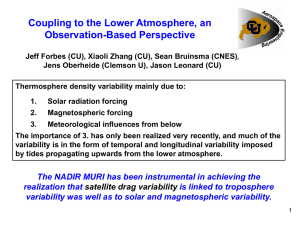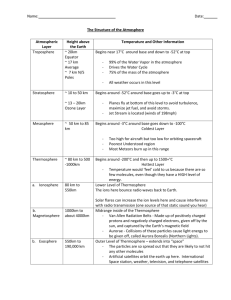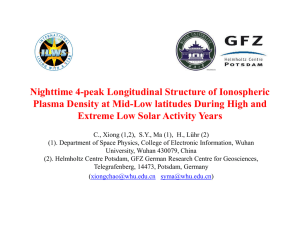CHAMP-April2002
advertisement
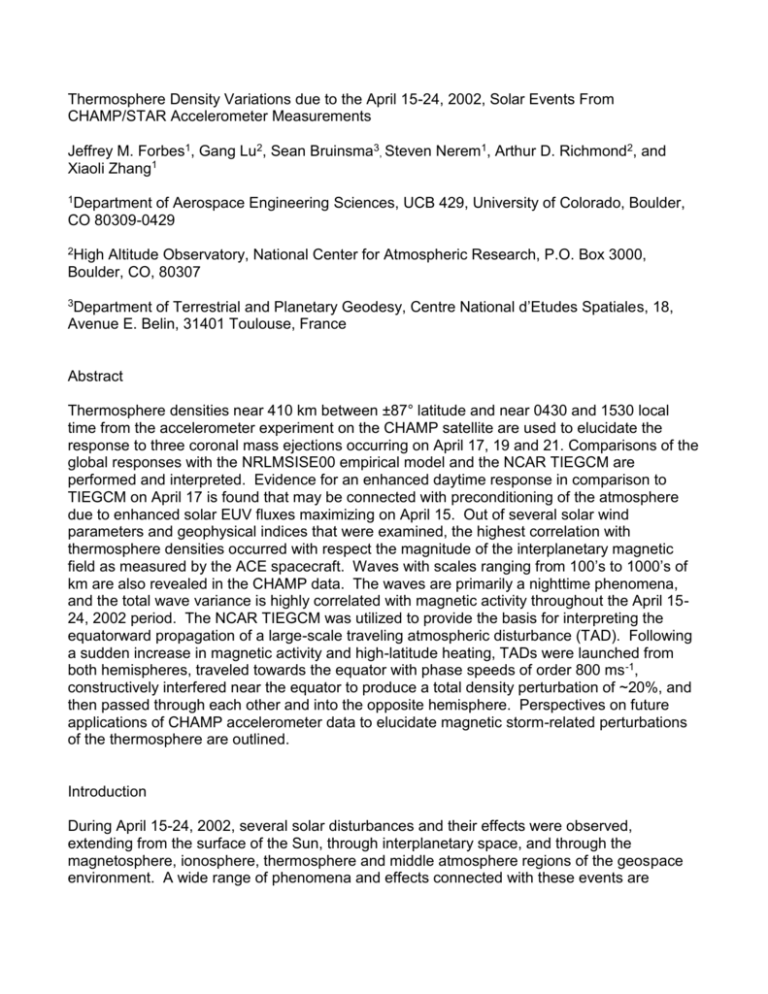
Thermosphere Density Variations due to the April 15-24, 2002, Solar Events From CHAMP/STAR Accelerometer Measurements Jeffrey M. Forbes1, Gang Lu2, Sean Bruinsma3, Steven Nerem1, Arthur D. Richmond2, and Xiaoli Zhang1 1Department of Aerospace Engineering Sciences, UCB 429, University of Colorado, Boulder, CO 80309-0429 2High Altitude Observatory, National Center for Atmospheric Research, P.O. Box 3000, Boulder, CO, 80307 3Department of Terrestrial and Planetary Geodesy, Centre National d’Etudes Spatiales, 18, Avenue E. Belin, 31401 Toulouse, France Abstract Thermosphere densities near 410 km between ±87° latitude and near 0430 and 1530 local time from the accelerometer experiment on the CHAMP satellite are used to elucidate the response to three coronal mass ejections occurring on April 17, 19 and 21. Comparisons of the global responses with the NRLMSISE00 empirical model and the NCAR TIEGCM are performed and interpreted. Evidence for an enhanced daytime response in comparison to TIEGCM on April 17 is found that may be connected with preconditioning of the atmosphere due to enhanced solar EUV fluxes maximizing on April 15. Out of several solar wind parameters and geophysical indices that were examined, the highest correlation with thermosphere densities occurred with respect the magnitude of the interplanetary magnetic field as measured by the ACE spacecraft. Waves with scales ranging from 100’s to 1000’s of km are also revealed in the CHAMP data. The waves are primarily a nighttime phenomena, and the total wave variance is highly correlated with magnetic activity throughout the April 1524, 2002 period. The NCAR TIEGCM was utilized to provide the basis for interpreting the equatorward propagation of a large-scale traveling atmospheric disturbance (TAD). Following a sudden increase in magnetic activity and high-latitude heating, TADs were launched from both hemispheres, traveled towards the equator with phase speeds of order 800 ms -1, constructively interfered near the equator to produce a total density perturbation of ~20%, and then passed through each other and into the opposite hemisphere. Perspectives on future applications of CHAMP accelerometer data to elucidate magnetic storm-related perturbations of the thermosphere are outlined. Introduction During April 15-24, 2002, several solar disturbances and their effects were observed, extending from the surface of the Sun, through interplanetary space, and through the magnetosphere, ionosphere, thermosphere and middle atmosphere regions of the geospace environment. A wide range of phenomena and effects connected with these events are addressed throughout this special issue. The present paper is primarily concerned with the response of the thermospheric total mass density to the two halo coronal mass ejections launched from solar active region 9906 at 0406 UT on April 15 and at 0826 UT on April 17, respectively. After a period of geomagnetic quiet, the first interplanetary CME from this region triggered a magnetic storm on April 17. Before the geospace environment recovered from this storm, a second magnetic storm was produced by impact of the second CME on April 19. Geomagnetic activity returned to quiet levels by midday on April 21. At 0127 UT on April 21, a third CME was launched from the same active region (now approaching the solar limb), but its interaction with the geospace environment was not direct. This CME produced a smaller geomagnetic disturbance than the first two, but nevertheless produced an easily detectable thermosphere response (see below). There exists a significant literature on the neutral thermosphere temperature, composition, and density response to variations in geomagnetic activity (i.e., magnetic storms and substorms as reflected in magnetic indices such as Kp and ap). Our earliest knowledge of total mass density variability was derived from changes in satellite orbits, constrained by rocket measurements of neutral composition in the lower thermosphere, the hydrostatic law, and assumptions about the vertical structure of temperature above 100 km (cf. Jacchia, 1971). Our present ability to empirically specify the neutral density response to magnetic storms is embodied in models such as MSISE90 (Hedin, 1991) and the recent update to this model developed by the Naval Research Laboratory, NRLMSISE00 (Picone et al., 2002). The latter models are distinguished from the earlier drag-based models as they incorporate satellite measurements of composition and temperature, as well as ground-based measurements of temperature from incoherent scatter radars. However, the above models are statistical in nature, being based upon fits to large arrays of data taken over a range of local times, latitudes, levels of solar and magnetic activity, etc. In addition, many of the satellite measurements are made in eccentric orbits, so that the variation in the temporal response with latitude is only gleaned on a statistical basis. As such, as we shall see in the following, even the most recent empirical models achieve very limited success in reproducing density variations during individual storms. Apart from the development of empirical models, there have been some very comprehensive studies of the thermosphere response to magnetic storms. The review paper by Prolss (1980) is a good example, wherein analyses of mass spectrometer data from the OGO satellite provide insight into the spatial and temporal response of thermospheric composition to geomagnetic activity. He discusses a number of important features of the response, including composition variations that suggested the presence of upwelling, the equatorward propagation of large-scale disturbances, etc. The CHAMP satellite was launched on July 15,2000, and carries the CNES/STAR triaxial accelerometer. Relevant details concerning CHAMP and the STAR accelerometer are provided below. During April 15-24, 2002, CHAMP was in a near-circular (~390-430 km) highinclination (87°) orbit, with the STAR accelerometer providing approximate measurements of total mass density along the orbit with 10-second (~80 km) resolution. Thus, the opportunity exists to delineate the spatial-temporal response of thermosphere density to the two halo CMEs launched from the Sun on April 15 and 17, 2002, at a near-constant altitude and extending nearly from pole to pole at two local times (i.e., along upleg and downleg portions of the orbit). We thus have the opportunity to observe the global thermosphere response to the first CME following a period of geomagnetic quiet during very high solar activity levels, the response of a pre-conditioned (disturbed) thermosphere to the second CME, and then return of the thermosphere to quiet levels. In addition, the sampling characteristics of CHAMP/STAR provide the opportunity to examine the response characteristics at small (~100’s kms) as well as global (~1,000’s kms) scales. It is the purpose of this paper to provide these perspectives, and to illustrate the potential contributions of the CHAMP data set to the study of thermospheric storms. The following section provides further information about the CHAMP satellite, the STAR accelerometer, the nrlMSISE90 and NCAR TIEGCM models that are compared with the accelerometer measurements, and the solar wind data that are used to examine relationships with thermosphere density. Data and Models The CHAMP (CHAllenging Minisatellite Payload) satellite (http://op.gfz-potsdam.de/champ/) is managed by the GeoForschungsZentrum (GFZ) in Potsdam, Germany, and among other instruments carries the STAR (Spatial Triaxial Accelerometer for Research) accelerometer provided by the Centre National d'Etudes Spatiales (CNES) and manufactured by the Office National d'Etudes et de Recherches Aerospatials (ONERA). The primary mission objectives are mapping of the gravity and magnetic fields of the Earth, and monitoring of the lower atmosphere and ionosphere. Measurement of thermospheric density is a secondary objective for the mission. All aspects of the mission and the accelerometer experiment (including calibration and error and bias analyses) relevant to the present work are detailed by Bruinsma et al. (2004), and will not be repeated here. The drag force sensed by the accelerometer is proportional to 1 A 2 CD VSat VAtm 2 M where CD = drag coefficient, A = satellite area in ram direction, M = satellite mass, = total mass density of the atmosphere, Vsat-Vatm = satellite velocity relative to the atmosphere. Other forces sensed by the accelerometer (such as Sun, Earth and lunar gravity, Earth albedo, solar radiation pressure, etc.,) are accounted for using models. As noted by Bruinsma et al. (2004), values of CD, A and M, as well as other forces sensed by the accelerometer are known reasonably well. The largest source of error in inferring densities from in-track accelerations is due to neutral winds, which are normally assumed equal to zero. For a Vsat ~ 8 kms-1, a 100 ms-1 wind implies a 2.5% error in inferred density, whereas a 750 ms-1 wind implies a 20% error. The latter is likely to only be reached at high latitudes under highly disturbed conditions; moreover, as we shall see, density perturbations under these conditions are of order 200300%, so errors of this magnitude are tolerable. During April 15-24, 2002, CHAMP was in a near-circular (385 x 430 km) orbit with inclination of 87.3. The Level-2 data utilized here correspond to a 10-second sampling interval, which translates to about 80 km in-track horizontal resolution. To numerically simulate the ionosphere/thermosphere response to the storm, time-dependent patterns of ionospheric convection and auroral precipitation derived from the assimilative mapping of ionospheric electrodynamics (AMIE) procedure [Richmomd and Kamide, 1988] are used as inputs to the thermosphere-ionosphere general circulation model (TIEGCM) [Richmond et al., 1992]. The 5-minute AMIE patterns in both northern and southern hemispheres are derived by fitting the observations from three DMSP (F13, F14, and F15) and three NOAA (14,15, and 16) satellites, the SuperDARN HF Radar network, and 152 ground magnetometers distributed worldwide. In addition, global auroral images from the IMAGE satellite are used to determine the auroral energy flux as well as the height-integrated Pedersen and Hall conductances when the satellite was passing over the northern hemisphere. The AMIE patterns were interpolated to a 2-minute time step in which the TIEGCM simulation was carried out, and the model history volumes were recorded every 10 minutes. In addition to the ionospheric inputs from AMIE, the TIEGCM also incorporates the diurnal and semidiurnal tides from the Global Scale Wave model (GSWM) (Hagan et al., 1999), and solar EUV and UV flux as parameterized by the F10.7 index. The model has an effective 5° latitude by longitude geographic grid and 29 constant pressure levels extending approximately from 97 to 680 km in altitude. A reference quiet-time background is obtained from a 24-hour model run using the same ionospheric inputs at 0000 UT on April 15 but fixed in local time and magnetic latitude as the Earth rotates. The solar wind data was provided by the Advanced Composition Explorer (ACE) satellite mission. See http://www.srl.caltech.edu/ACE/ace_mission.html for details. Results Global-scale Response Figure 1 illustrates the latitude versus time response of thermosphere density at 410 km for the upleg (average LST = 1530h) and downleg (average LST = 0430h) portions of the CHAMP orbit consistent with (a) the CHAMP/STAR accelerometer measurements; (b) the TIEGCM; and (c) the NRLMSISE00 empirical model. These plots provide an opportunity to qualitatively compare differences in salient global features, and to acquire an overall impression of the capabilities of the most recent and comprehensive first-principles and empirical models. Note that the color scales are different in each panel of Figure 1, in order to illustrate the complete dynamic range for each. The difference in the midpoints of the color scales provides a rough measure of the mean differences of the models from the observations: about –5 to -10% for NRLMSISE00 and –20% for TIEGCM. There are two quiet intervals (Kp < 3) indicated in Figure 1, the first occurring on April 16, and the second on April 21. The CHAMP/STAR densities are significantly higher on April 16 than April 21 during both day and night, and this effect is reflected to some degree in the NRLMSISE00 model, but not the TIEGCM. The CHAMP densities reflect the very high solar flux levels that maximized at F10.7=227 on April 13, reduced to 205 on April 15, and declined steadily to a value of 179 by the end of the April 15-24, 2002 interval. The enhanced densities on April 16 appear to have pre-conditioned the thermosphere to enhance the geomagnetic response on April 17. This deficiency for the TIEGCM may have been due to the fact that the thermospheric inflation due enhanced solar activity prior to April 16 was not fully included in the initial conditions for this simulation. Between the two quiet intervals are two periods of active magnetic activity (Kp > 6), which we will refer to as storm 1 and storm 2. The TIEGCM density response for storm 1 is much weaker than CHAMP/STAR during both day and night, and as noted above this may be due to the fact that preconditioning of the thermosphere (i.e., the elevated densities on April 16 noted above) were not taken into account in the TIEGCM. However, for storm 2, there is a significant amount of similarity in terms of amplitude and spatial-temporal structure between the observations and the TIEGCM on the dayside. On the nightside, however, while similar response amplitudes are indicated at high latitudes, at low latitudes the TIEGCM overestimates the response. There are also many differences in fine details at both high and low latitudes, primarily related to various-scale waves that appear in both the simulation and in the data. To some degree some of these differences may reflect errors imposed by the neglect of neutral winds in the estimation of density from the CHAMP accelerometer measurements (cf. Equation 1), especially at high latitudes. In addition, density variations at scales of order 80 km are captured in the density measurements, whereas the horizontal resolution of the TIEGCM is 5 latitude (~500 km). Some aspects of the small-scale waverelated density response structures will be discussed in the following subsection. During daytime, the NRLMSISE00 model underestimates the response at high latitudes, but provides a reasonably smoothed depiction of the response at middle and low latitudes. Significant high-latitude density perturbations appear in the model at nighttime, but underestimate their intensity and latitudinal extent in comparison to the CHAMP densities. It is important to add, however, that the NRLMSISE00 model is based upon a spherical harmonic expansion, and cannot be expected to capture any of the patchiness evident in the data and in the TIEGCM. In order to gain a more quantitative perspective on the large-scale thermosphere density response, correlations at different time lags were computed between density variations and various parameters representing precursors related to energy input into the thermosphere. A summary of these results is provided in Table 1. The parameters examined include the a p, Kp, and AE Dst indices; the magnitude |B| and vertical component Bz of the interplanetary magnetic field; log10 where is the epsilon parameter; PC is the N. Hemisphere polar cap index (www.dmi.dk/projects/wdcc1/); Pdyn is the dynamic pressure of the solar wind; Vp is the solar wind speed; and the cross-cap potential and Joule heating rate from the AMIE/TIEGCM results. Note that at 60 the quantity with highest correlation (R = 0.74) with density variations is the magnitude of the interplanetary magnetic field |B| measured by ACE 6 hours earlier, whereas at the equator AE shows nearly the same correlation (R = 0.79) as |B|, with other variables (Kp, R = 0.75; ap, R = 0.78; and Joule heating (R = 0.73) close behind. The density lag times at the equator are 3-4 hours, which is not consistent physically with the 6hour lag at high latitudes. For many cases, the correlation coefficients are lower during daytime as opposed to nighttime. Table 1 Linear correlation coefficients and lag times between various solar wind parameters and geophysical indices, and density variations at –60°, +60° and 0° latitude. Table 1 here Examples are shown in Figure 2. The bottom two panels illustrate nighttime densities at the equator and magnitude of the interplanetary magnetic field |B| measured by ACE versus time, and the cross-correlation coefficient as a function of lag between |B| and density. The maximum correlation is 0.786 at a lag of 4 hours. The top panel illustrates nighttime densities at -60 latitude versus the 3-hourly ap index. The linear correlation coefficient is 0.708 at a lag of 5 hours (see Table 1). Note the increases in ap and |B| occurring on April 23. These are most likely associated with the third “indirect” CME launched from the Sun on April 21, and are accompanied by a smaller but clearly detectable density response compared to the first two CMEs. Although these results may be interesting and thought-provoking, it must be recognized that a 10-day interval is rather short to arrive at statistically reliable results. In addition, better correlations might be obtained by combining one or more independent variables in a multiple linear regression formulation. This type of analysis is currently underway utilizing several years of CHAMP data, and will be reported on in the future. Waves and Traveling Atmospheric Disturbances (TADs) The high spatial and temporal resolutions afforded by accelerometer data permit a different perspective on the thermosphere density response than is possible using orbital drag data. The CHAMP measurements make possible delineation of the amplitude and time delay of the density response as a function of latitude, for both hemispheres, on opposite sides of the Earth. This response is manifested in part by a spectrum of waves that are generated by impulsive heating at high latitudes, and that can propagate and dissipate large distances from the source. Mayr et al. (1990) provide an excellent review of theory and observations relating to this problem. During disturbed periods, it is very common to see wave-like structures in the CHAMP accelerometer measurements. A typical example of these wave structures following the sudden increase in geomagnetic disturbance on April 17, 2002, is illustrated in Figure 3 for three consecutive nighttime orbits. Perturbations with horizontal scales of ~5-10° latitude and amplitudes of order 5-20% are clearly evident. The presence of wavelike structures in thermosphere neutral density measurements is not new (see, for instance, Gross et al., 1984; Hoegy et al., 1979; Hedin and Mayr, 1987; Prolss, 1980; Forbes et al., 1995). Due to poor time resolution of the measurements at a given latitude (i.e., the orbital period, or about 90 minutes), unambiguous interpretation of the propagation characteristics of wave-like features in satellite measurements is difficult. However, the sophistication of first-principles models of the thermosphere-ionosphere system has advanced considerably over the past 5-10 years, and they are now able to provide some context for interpretation of such measurements. In the following, we utilize the NCAR TIEGCM simulation to assist in interpretation of TADs launched equatorward from both polar regions during the increase in magnetic activity on April 19, 2002. Figure 4 provides a comparison between CHAMP and TIEGCM total mass densities at 410 km in conjunction with the magnetic disturbance on April 19, 2002. To remove the mean model/data bias, we actually plot density differences from the pole-to-pole latitudinal mean value of total mass density for both CHAMP and TIEGCM. The top panel illustrates contours of density differences at 410 km for one particular longitude sector from the TIEGCM, and the ground tracks of the CHAMP orbit. The four CHAMP orbits actually correspond to 4 different longitudes (hence the dashed lines), but the latitude-UT contours at the 4 longitudes in the TIEGCM did not differ very much except in fine details, so only one longitude sector, that corresponding to the first CHAMP orbit (solid line), is indicated here to conserve space. The remaining panels illustrate the latitude variation of perturbation densities along the 4 CHAMP orbits (nightside ~0430 only) illustrated in the top panel. From analysis of the full TIEGCM model results, it is possible to interpret the meaning of the large-scale wave structures observed by CHAMP. The scenario goes as follows: Orbit 1 is pre-disturbance. The broad latitudinal structures reflected in the CHAMP data and the TIEGCM agree with each other. Note that there is considerable fine structure in the CHAMP observations that cannot be resolved with the 5° latitude resolution of the TIEGCM. In Orbit 2, we see large-scale density disturbances (‘traveling atmospheric disturbances’ or TAD’s) traveling through middle latitudes in both hemispheres, after being launched in their respective auroral regions. Peak-to-peak amplitudes are about 30-50% for TIEGCM and 20-35% for CHAMP, and the phase speed is about 800 ms-1 for TIEGCM and xxxx ms-1 for CHAMP. In Orbit 3, the waves constructively interfere to produce enhancements of +60% (TIEGCM) and +20% (CHAMP) near the equator and negative excursions of 30-35% and 10-20%, respectively, at middle latitudes. Between orbits 3 and 4 the disturbances pass through each other, and in Orbit 4 have reached midlatitudes in the opposite hemisphere. The subsequent orbit (not shown) looks similar to that of Orbit 1. In a series of papers, A.D. Richmond (Richmond and Matsushita, 1975; Richmond, 1978a,b; 1979a,b) performed 2-D simulations of hydrostatic gravity waves generated by suddencommencement-like auroral heating input. Based upon interpretation of these results, he drew the following conclusions that are most relevant for present purposes: a. Only the longest-period fastest-moving waves travel far from the source. b. A distinctive feature of the middle to low latitude wave response is a disturbance front that moves equatorward at about 750 ms-1 near 400 km, and about half this speed near 200 km. c. The front passes into the opposite hemisphere with little attenuation. d. The disturbance duration increases with increasing distance from the source and with decreasing altitude. e. Ion drag is expected to attenuate waves to a significantly greater degree during daytime as opposed to nighttime. f. Gravity wave transport is less important than meridional advection in transporting energy from high to low latitudes. Several of these conclusions are consistent with the present CHAMP results, and hold for all of the measurements between April 15 and 24, 2002: The small-scale structures remain confined to high latitudes. The phase speed of the TAD is consistent with Richmond’s prediction at this altitude, and penetration into the opposite hemisphere is observed. Wave structures are generally very depressed during daytime as opposed to nighttime, presumably due to the higher level of ion drag dissipation. In addition, the meridional flow associated with the diurnal cycle of EUV forcing, which tends to be equatorward (poleward) during night (day), may also serve to facilitate equatorward penetration of the disturbance during nighttime (See Forbes et al., 1996, and related discussion in the context of modeling work by Fuller-Rowell et al., 1996). A simple quantitative estimate for the evolution of wave activity during April 15-24, 2002, is provided by calculating the variance about the mean on an orbit by orbit basis. In this case, the residuals are taken about a 45-degree latitude running mean, effectively serving as a highpass filter (admitting scales less than about 20° latitude), so that the maxima at high latitudes depicted in the panels of Figure 4 are removed. The variation of the orbit variance with time is compared in Figure 5 with Kp, demonstrating a very high correlation. This implies that it should be possible to specify and to some degree predict the variability of the thermosphere over a range of scales. Although out of the scope of the present paper, the CHAMP data can play a role in validating the level of variability predicted by first-principles models. A future study is planned to examine the variation of wave power over various spectral ranges (cf. Forbes et al., 1995) as a function of magnetic activity and other parameters, using several years of CHAMP data. Conclusions The thermosphere density responses of two halo CMEs interacting with Earth’s geospace environment occurred at scales ranging from small-scale (100’s of km) structures that remain confined to high latitudes, to traveling atmospheric disturbances (TADs) with scales of 1000’s of km that propagate far from their high-latitude sources, and to density perturbations that spread globally due to advection. State-of-the-art empirical (NRLMSISE90) and numerical (NCAR TIEGCM) models achieve moderate success at reproducing the global-scale responses, although there are notable deficiencies. For the first storm, it appears that preconditioning due to enhanced solar EUV fluxes may have led to an amplified geomagnetic response. Although expelled near the limb of the Sun, a third CME appears to have produced a distinct density response, although much smaller in magnitude than the first two disturbances. Among a number of solar wind parameters and geophysical indices, the globalscale density variations are best correlated with the magnitude of the interplanetary magnetic field as measured by the ACE spacecraft; however, it is cautioned that the present 10-day interval does not represent a very large statistical sample. The TIEGCM realistically simulates a pair of TADs observed in the CHAMP data that are launched out of the northern and southern auroral regions, propagate equatorward, constructively interfere near the equator, and pass with little attenuation into the opposite hemisphere. The CHAMP data also reveal wavelike structures with scales of 100’s of km that are confined to high latitudes; these are not capable of being captured by the 5° latitude resolution of the TIEGCM. Both scales of waves primarily occur at nighttime, and the orbit-byorbit density variances due to the waves are well correlated with K p. Many of the observed aspects of the thermosphere wave response are in accord with theoretical expectations as outlined by Richmond and Matsushita (1975) and Richmond (1978a,b; 1979a,b). This paper is the first in a series to examine the thermosphere response to magnetic storms as well as solar EUV variations. Since the CHAMP satellite precesses through 24 hours of local time every 130 days, and is expected to provide useful data from about 2001 to 2006, the opportunity exists to delineate local time and seasonal variations in total mass density; the thermosphere response to short-term (~1-27 day) and long-term (~yearly) variations in solar EUV flux; the dependence of the global-scale geomagnetic response on season, local time and solar cycle; and the small-scale (~100’s km) variability of thermosphere density. In addition, we expect to provide and analyze measurements of winds determined from the crosstrack accelerometer on CHAMP. All of these efforts are ongoing and will be reported on in the future. References Bruinsma, S., Tamagnan, D., and R. Biancale, Atmospheric densities derived from CHAMP/STAR accelerometer observations, Planet. Space Sci., 52, 297-312, 2004. Forbes, J.M., Gonzalez, R., Marcos, F.A., Revelle, D., and H. Parish, Magnetic storm response of lower thermosphere density, J. Geophys. Res., 101(A2), 2313-2319, 1996. Forbes, J.M., Marcos, F.A., and F. Kamalabadi, Wave structures in lower thermosphere density from Satellite Electrostatic Triaxial Accelerometer (SETA) measurements, J. Geophys. Res., 100(A8), 14693-14702, 1995. Fuller-Rowell, T. J., Codrescu, M. V., Rishbeth, H., Moffett, R. J., Quegan, S., On the seasonal response of the thermosphere and ionosphere to geomagnetic storms, J. Geophys. Res.,101(A2), 2343-2354, 1996. Gross, S. H., C. A. Reber, and F. T. Huang, Large-scale waves in the thermosphere observed by the AE-C satellite, IEEE Trans. on Geos. and Remote Sens., GE-22, 340-352, 1984. Hagan, M.E., M. D. Burrage, J. M. Forbes, J. Hackney, W. J. Randel, and X. Zhang, GSWM98: Results for migrating solar tides, J. Geophys. Res., 104, 6813-6828, 1999. Hedin, A.E., Extension of the MSIS Thermosphere Model into the Middle and Lower Atmosphere, J. Geophys. Res., 96, 1159-xxxx, 1991. Hedin, A. E., and H. G. Mayr, Characteristics of wavelike fluctuations in Dynamics Explorer neutral composition data, J. Geophys. Res., 92, 11159-11172, 1987. Hoegy, W. R., P. L. Dyson, L. E. Wharton, and N. W. Spencer, Neutral atmospheric waves determined from Atmosphere Explorer measurements, Geophys. Res. Lett., 6, 187-190, 1979. Jacchia, L.G., Revised static models of the thermosphere and exosphere with empirical temperature profiles, Smithson. Astrophys. Obs. Spec. Rept., 332, 1971. Mayr, H. G., I. Harris, F. A. Herrero, N. W. Spencer, F. Varosi, and W. D. Pesnell, Thermospheric gravity waves: Observations and interpretation using the transfer function model (TFM), Space Sci. Rev., 54, 297-375, 1990. Picone, J. M., Hedin, A. E., Drob, D. P., Aikin, A. C., NRLMSISE-00 empirical model of the atmosphere: Statistical comparisons and scientific issues, J. Geophys. Res., 107, A12, 1468, doi:10.1029/2002JA009430, 2002. Prolss, G. W., Magnetic storm associated perturbations of the upper atmosphere: Recent results obtained by satellite-borne gas analyzers, Rev. Geophys. Space Phys., 18, 183202, 1980. Richmond, A.D., Gravity wave generation, propagation, and dissipation in the thermosphere, J. Geophys. Res., 83, 4131-4145, 1978a. Richmond, A.D., The nature of gravity wave ducting in the thermosphere, J. Geophys. Res., 83, 1385-1389, 1978b. Richmond, A.D., Thermospheric heating in a magnetic storm: Dynamic transport of energy from high to low latitudes, J. Geophys. Res., 84, 5259-5266, 1979a. Richmond, A.D., Large-amplitude gravity wave energy propagation and dissipation in the thermosphere, J. Geophys. Res., 84, 1880-1890, 1979b. Richmond, A. D, and Y. Kamide, Mapping electrodynamic features of the high-latitude ionosphere from localized observations: Technique, J. Geophys. Res., 93, 5741-5759, 1988. Richmond, A.D., and S. Matsushita, Thermospheric response to a magnetic substorm, J. Geophys. Res., 80, 2839-2850, 1975. Richmond, A. D., E. C. Ridley, and R. G. Roble, A thermosphere/ionosphere general circulation model with coupled electrodynamics, Geophys. Res. Lett., 19, 601-604, 1992. Acknowledgments. CHAMP is managed by the GeoForschungsZentrum (GFZ), Potsdam, Germany. The STAR accelerometer was manufactured by the Office National d'Etudes et de Recherches Aerospatials (ONERA) and provided by the Centre National d'Etudes Spatiales (CNES), France. The research reported here is supported under Grant ATM xxxxx from the National Science Foundation as part of the National Space Weather Program. Figure Captions Figure 1. Comparison of latitude vs. time structures of total mass density at 410 km during April 16-22, 2002, near 1530 LT (left) and 0430 LT (right) from the CHAMP accelerometer (top), NCAR TIEGCM (middle) and NRLMSISE00 (bottom). Figure 2. Top: Nighttime densities at -60 latitude versus the 3-hourly ap index. Middle: Nighttime densities at the equator, and magnitude of the interplanetary magnetic field |B| measured by ACE versus time. Bottom: cross-correlation coefficient as a function of lag between |B| and density as given in the middle panel. The maximum correlation is 0.786 at a lag of 4 hours. Figure 3. Density wave structures at 410 km on 3 consecutive orbits on April 17, 2002, inferred from the CHAMP accelerometer measurements. Figure 4. Comparison of CHAMP and TIEGCM densities during a magnetically-disturbed period on April 19, 2002. Orbit 1 is pre-disturbance. In Orbit 2, we see large-scale density disturbances (‘traveling atmospheric disturbances’ or TAD’s) traveling through middle latitudes in both hemispheres, after being launched in their respective auroral regions. In Orbit 3, the waves constructively interfere at the equator and middle latitudes, pass through each other, and on Orbit 4 the TADs are passing into the opposite hemisphere. Figure 5. Orbit-by-orbit density variance (horizontal scales < 20° latitude) and Kp vs time.
